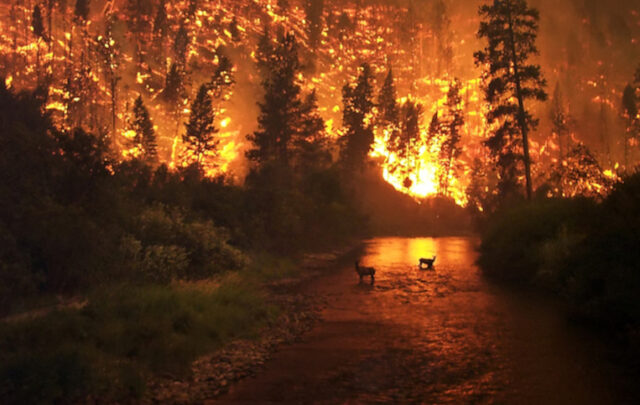Global thirst for crude oil keeps growing, despite the current high prices. Just how much oil does the world have left, and what will happen when demand begins to outstrip supply?
Last month the Paris-based International Energy Agency (IEA) released its World Energy Outlook 2004, a report detailing energy projections to 2030.
The outlook’s central message was optimistic. “The Earth contains more than enough energy resources to meet demand for many decades to come,” Claude Mandil, IEA’s executive director, told assembled press. “The world is not running out of oil just yet.”
However, Mandil also called for urgent policy responses to meet rising energy demand around the world and continued reliance on fossil fuels—issues he labeled “deeply troubling.”
Some experts express even greater concern than Mandil and caution that oil may run short much sooner than the IEA forecasts.
How Much Is Left?
Robert Kaufmann, a professor at Boston University’s Center for Energy and Environmental Studies, said that it is difficult to estimate global oil reserves because data is not always reliable.
“In the U.S. we have very strict requirements for what’s considered a proven reserve,” he said. Such regulation is partially driven by the U.S. Securities and Exchange Commission (SEC), the federal market regulator, because the value of oil-related stocks depends largely on how much oil remains in the ground.
“A lot of the countries on whom we depend [for oil], like Saudi Arabia and Mexico, don’t have strict standards for proven reserves,” Kaufmann said. “Government-owned industries don’t have to satisfy an SEC, and you can’t blame them for not wanting to make that knowledge public. That makes a statistical analysis of the data difficult.”
The IEA has also recognized the problem and called for new, universal standards to estimate reserves.
Without solid data, forecasts range substantially. And Dan Butler, a market analyst with the U.S. Energy Information Administration, notes that improving technologies can squeeze more oil out of existing reserves. “It’s still a true statement that when you find oil you end up getting only 30 to 35 percent of that oil out of the hole,” he said. “If improving technologies can add another percent to that on a worldwide basis, that’s a big number. That’s a significant number of barrels. We’re clearly not in the park of those that say this decade could see the peak of oil.”
Yet some experts suggest that production capacity could be as limiting as the finite amount of oil available to extract around the world.
“It’s an undeniable fact that there’s a lot of oil under the ground in the Middle East,” said Jim Meyer, director of the Oil Depletion Analysis Centre (ODAC), a London-based nonprofit. “But there have been some very serious questions raised about the ability of the Saudi Arabians, and of the Middle East nations in general, to increase production substantially above current levels. The IEA has suggested that Saudi Arabia can double or triple production over the next 30 years, and that seems an impossibility to many experts.”
System at Full Capacity
Today’s high prices don’t necessarily signify the immediate end of cheap oil. Rather, they reveal an oil production system that is running at full capacity with little surplus, experts say.
“Whenever any factory or system runs at full capacity, prices get tight,” Kaufmann, the Boston University professor, said. “That’s part of the problem, and another problem is worry about existing capacity going offline.”
Such supply disruptions can occur in numerous ways. Scenarios include rebel attacks on an Iraqi pipeline to continuing political pressure on the Russian oil giant Yukos.
Oil demand, fueled by developing nations like China, will continue to grow at 1.6 percent a year, from 82 million barrels a day today to 121 million barrels a day by 2030, according to IEA estimates.
Much of the world’s oil will pass through what the IEA terms “vital chokepoints,” in the foreseeable future. This increases the possibility of a supply disruption, as well as global dependence on a small number supplier nations, according to the agency.
Many OPEC nations also present economic barriers to increased oil production. Such countries generally don’t allow foreign investment, yet lack the ready cash to increase production capacity on their own.
IEA estimates that some three trillion dollars (U.S.) in new investments will be necessary to boost oil-production capacity to the demand levels forecast for 2030.
“Economically, it’s not really in OPEC’s best interest to quickly increase capacity, because prices would fall faster than their ability to sell more oil, leading to net revenue loss,” Kaufmann said.
Higher prices could have a supply upside, promoting alternative and expensive oil-extraction and energy-supply technologies, such as obtaining crude oil from oil-rich Canadian sands and shale.
Rising per-barrel prices may make these new energy sources feasible, though some are not proven and many threaten significant environmental impact. If these new sources do become common, their high costs will be passed on to oil buyers.
“In all likelihood we’re living through the end of the cheap oil era,” Meyer, the Oil Depletion Analysis Centre director, said. “What will follow, at some point, is a decline era, due to the physical geology of oil reserves. This doesn’t mean that we’re running out of oil, but it means that every year less will be produced. And if the world needs more, there simply won’t be the ability to supply it.”
Last month Mandil, the IEA executive director, called for more vigorous action to “steer the global energy system onto a more sustainable path.” He urged governments to take the lead in accelerating the development and deployment of new technologies “that allow us to meet our growing energy needs without compromising our energy security and the environment.”
While forecasts differ on how long cheap oil may last, ODAC’s Meyer says now is the time to prepare. The end of cheap oil is “within sight, let’s put it that way, no matter whose analysis you consult,” he said.
“It’s either with us now, or rapidly approaching, or maybe it’s 20 or 30 years away. The key is that it’s inevitable, within some foreseeable time frame, and right now we’re ill prepared for addressing the problem when it comes.”





